2024 Nissan Z Review: Classic looks, classic fun, iffy value

Pros: Strong value; gorgeous styling; good infotainment system; it’s a fun-to-drive rear-drive sport coupe; especially excellent Nismo model
Cons: Subpar transmissions; tight interior with only two seats; compromised trunk; Nismo is expensive and auto only
The 2024 Nissan Z is a beautiful and fun rear-wheel-drive sports car with varying degrees of value. On the one hand, the base model offers a rip-snorting twin-turbo V6 and your choice of a manual or automatic for relatively little money. But on the other, you have the new-for-this-year Nismo, which although is the best one to drive, has a price tag that makes it tricky to recommend.
There’s also the slight issue of the Z not quite reaching the highs of some of its competitors. For instance, we’ve found its most direct rival, the Toyota Supra, to be a better sporting machine. And there’s other compelling competition from the Ford Mustang and a handful of sporty BMW two-doors.
Of course, one trick the Z has up its sleeve is its styling. It’s a highlight reel of some of the best cues from all of Z history, from the 240Z-inspired nose to the Z32 300ZX-inspired tail (and it gets even more referential with the new-for-2024 Heritage Edition). There’s not a bad angle on it, even when you can spot where the old 370Z kind of sticks out. And the interior features quite attractive and easy-to-use technology incorporated in an equally attractive retro-inspired cockpit. So, the Z may not be a class leader, but there’s plenty of charm to keep it under consideration.
Interior & Technology | Passenger & Cargo Space | Performance & Fuel Economy
What it’s like to drive | Pricing & Trim Levels | Crash Ratings & Safety Features
What’s new for 2024?
There are two new additions to the Z lineup for 2024. The first, and most significant, is the Z Nismo. We go over it in-depth in our Nissan Z Nismo first drive review, but in short, it brings additional power and torque, upgraded suspension and brakes over the Z’s Performance trim, and unique exterior and interior treatments. It’s strangely only available with an automatic transmission, and it’s far and away the most expensive trim level.
The second new addition, which arrived rather late in the model year, is the 2024 Nissan Z Heritage Edition. Pictured above, it pays homage to the S30-generation Datsun 240Z in design and sits between the Z Performance and Z Nismo in the model hierarchy. Mechanically identical to the Performance with a choice of manual and automatic transmissions, it is effectively an extensive appearance package. It gets a reworked front fascia with more pronounced rectangular intakes and black graphics, plus broader fenders cover 19-inch wheels. There are stripes running down the hood, roof, and trunk lid, as well as black-out badges and Heritage Edition decals.
What are the Nissan Z interior and in-car technology like?
The Nissan Z interior is a great blend of modern technology and retro looks. Like past Z models, the center stack is canted toward the driver, as are the three dash-top analog gauges. Soft touch plastics are used across most of it, and the design really pops with some of the two-tone color options. There are some less-than-premium materials on items such as door handles, however, and in general, the Supra interior is the higher quality environment – which at least partially explains the price difference between them. For the Z’s price, though, the cabin’s look and quality are appropriate.
Perhaps the biggest advancement from one Z generation to the next are the big, vivid and easy-to-read screens. The instrument screen can be configured with different graphics and information to fit your preferences. It can even show an impressive amount of information about the Z’s mechanical bits. In addition to the basics such as speed, revs, fuel and coolant temperature, it has readouts for engine oil temperature, and pressure and differential oil temperature. Coupled with the analog turbo boost pressure, turbo rpm and voltage gauges atop the dash, you’ll be constantly aware of what’s going on under the hood. The infotainment system is also user-friendly and responsive, and incorporates Apple CarPlay and Android Auto. On the Performance, Heritage Edition and Z, those phone mirroring systems are wireless.
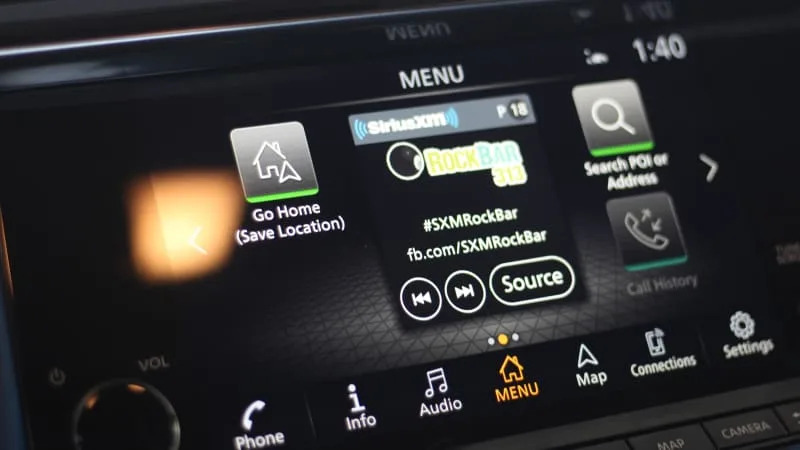
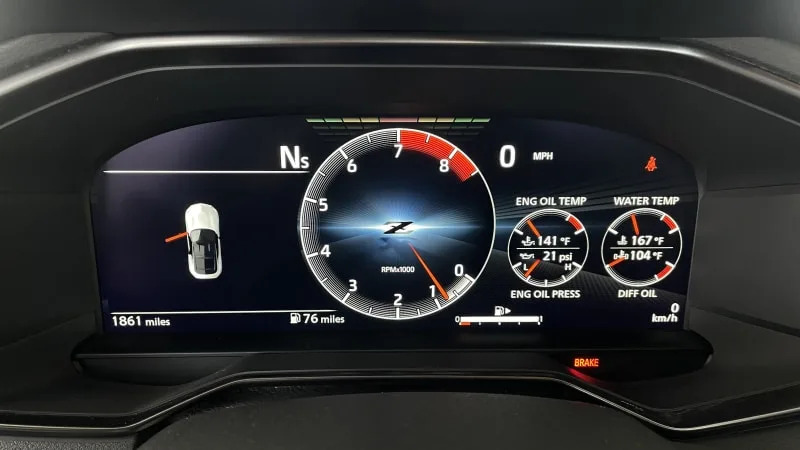
How big is the Z?
The Z is a bit smaller than the Ford Mustang, and it’s nearly the same size as its closest competitor, the Toyota Supra. Its exterior dimensions are only off by a few tenths in many measurements. The Z does weigh a bit more than the Supra, though. At the lightest, the Z weighs 3,486 pounds, and 3,602 pounds at the heaviest. The six-cylinder Supra 3.0 weighs in at 3,400 pounds. The much less powerful four-cylinder Supra 2.0 is even lighter at 3,181 pounds.
By the numbers, the Z and the Supra’s interior measurements are nearly identical, too. In reality, though, the Z feels much tighter than the Supra. The higher seating position makes headroom tighter, and the cabin feels narrower. This may be exacerbated by the slightly narrow seats with strong bolsters that aren’t the friendliest to bigger body types. It should also be noted that its two-seat interior won’t be for everyone – the back seats of a Mustang, BMW 2 Series or Toyota 86/Subaru BRZ may hardly be adult friendly, but for extra storage or canine transport, they can make a big difference.
As for cargo space, Nissan hasn’t given official numbers, but Car and Driver reports it has 7 cubic feet. That’s smaller than the Supra’s 10.2 cubic feet. The Z’s cargo area is also oddly shaped, as it’s shallow and wide. There’s also an awful lot of car to clear when lifting things up and into the trunk.
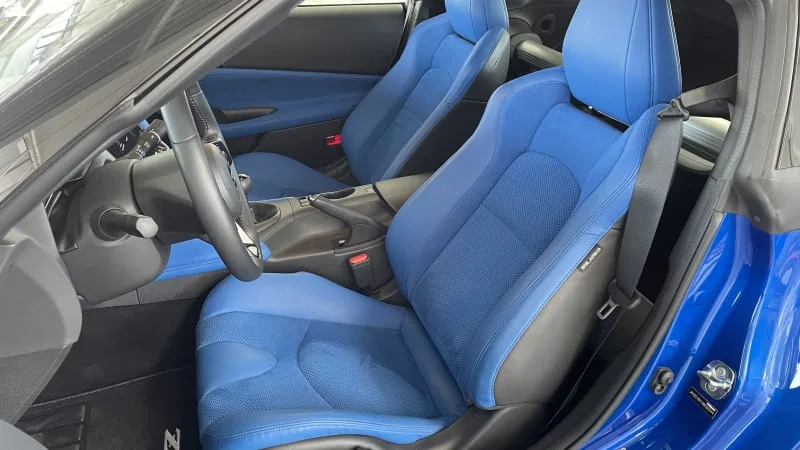
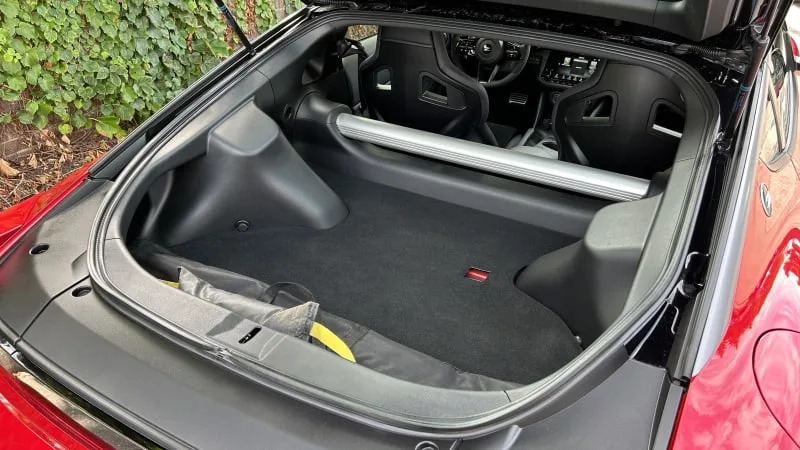
What are the Z fuel economy and performance specs?
Unlike most competitors (and the Toyota 86/Subaru BRZ twins are only sorta competitors), the Z has a single engine option: a twin-turbocharged 3.0-liter V6 that makes 400 horsepower and 350 pound-feet of torque. That’s more power than its closest competitor, the six-cylinder Toyota Supra 3.0, but slightly less torque. Power goes to the rear via your choice of a six-speed manual transmission or a nine-speed automatic transmission.
The base Sport model features an open differential, but upgrading to the Performance trim adds a clutch-type limited-slip differential. Brakes are larger front and rear (up 1.4 inches to 14 in the front, and up 1.7 inches to 13.8 at the rear). Furthermore, the Performance gets sport-tuned suspension, launch control, a higher top speed and automatic rev-matching for the manual transmission, which can be switched on and off.
Then there’s the Z Nismo. It’s only offered with the nine-speed automatic, but output increases to 420 horsepower and 384 pound-feet of torque. The front disc brakes expand to 15 inches in diameter, and even stickier tires are fitted to the slightly wider RAYS wheels. It gets stiffer suspension, additional chassis bracing and retuned steering.
Your choice of transmission will affect your fuel economy. The automatic is the more frugal model returning 19 mpg city, 28 mpg highway and 22 mpg combined. The manual drops economy to 18/24/20. Both are less efficient than the Supra 3.0. The Z Nismo, with its higher output, loses even a little more fuel economy, coming in at 17/24/19.
What’s the Z like to drive?
There’s a lot to like about driving the Nissan Z. The engine in particular is a blast. It’s torquey, responsive, and feels powerful even high in the rev range. It has a throaty, if slightly muted intake noise that’s fun, too.
Handling is predictable and fairly well-balanced. Steering is a little odd, feeling light at low speeds and rather heavy at higher speeds. The chassis is definitely stiffer than the 370Z’s, but it doesn’t feel as solid as the Supra’s. The suspension has a good tune for street use. It’s firm but not punishing, and there’s just some mild body roll. This is important since an electronically adjustable suspension isn’t available.
The real weak point for the Z is its transmissions. The manual is definitely the best choice. It offers more engagement, and the available automatic rev-matching is welcome. Of course, if you feel otherwise, it’s also easy to deactivate with the press of a button, and heal-toe downshift for yourself. Unfortunately, the shifter has long throws and feels a little rough going into gear. While we too want to Save the Manuals(!), this one could be better, which has long been a common refrain among Nissan do-it-yourself gearboxes. The automatic transmission is passable on the street in manual mode, but when driving harder or leaving it in automatic mode, it’s sluggish and not especially smooth. The Supra’s ZF eight-speed is far superior.
The Nismo model is the best of the Z line, and yes, that’s even despite the fact it’s only available with the nine-speed automatic. The stiffer suspension, stickier and wider tires and steering tuning make it a seriously responsive and communicative sports car. And it’s even still compliant on the street. It’s far and away the best handling and most fun to drive Z on the merits of its chassis alone. The extra 20 horsepower and 34 pound-feet of torque give it a little extra punch, though we didn’t find the base engine lacking. The automatic is improved, although it does still come up short of the aforementioned Supra ZF unit. As good as it is, it’s quite expensive at nearly $67,000, which means this may only be for Nissan fanatics.
What other Nissan Z reviews can I read?
2023 Nissan Z First Drive Review
Our first experience with the Z, including details about everything that changed from one generation to the next.
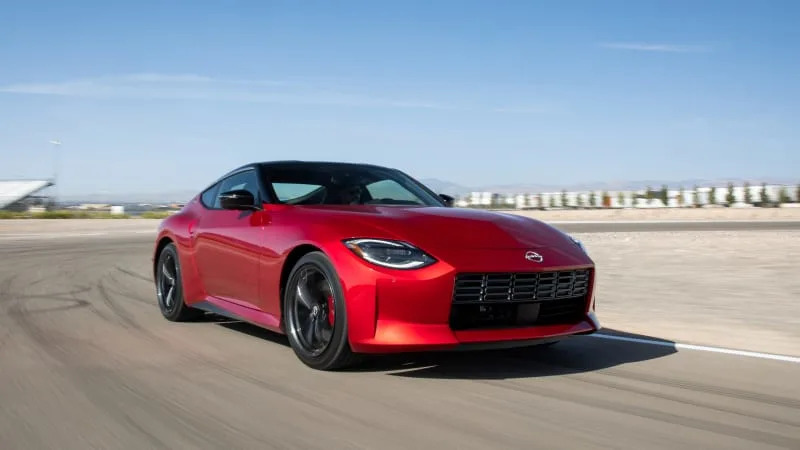
2024 Nissan Z Nismo First Drive Review
Our most comprehensive drive of the top-dog Z, including how it differs and what it’s like to drive on a track.

What is the 2024 Z price?
Pricing for the Z starts at $44,110 for the base Sport trim. The price is the same whether you go with a manual or automatic transmission, both on the Sport and the Performance. The Sport gets you 18-inch alloy wheels, LED lighting, 12.3-inch instrument screen, 8-inch infotainment screen, Apple CarPlay and Android Auto, automatic climate control, adaptive cruise control and parking sensors. With the automatic, the Sport also gets rev matching for downshifts and launch control.
The Performance trim, while an extra $10,000, significantly ups the, well, performance parts, as we mentioned above. On the outside it gets 19-inch forged RAYS wheels with wider tires plus front and rear spoilers. Inside, the seats get extra bolstering and leather with faux suede upholstery, plus power adjustment and heating. The sound system is upgraded to a Bose 8-speaker system with a 9-inch screen and wireless phone mirroring. The steering wheel gets fancier leather and the pedals have aluminum covers.
The 2024 Z Heritage Edition is mechanically identical to the Performance trim, but gets unique styling, including its front fascia, wider tires, 19-inch wheels and various badging/decals.
The Nismo brings extra power and suspension upgrades, but also Nismo-specific body work, and the interior includes Recaro seats, leather and Alcantara upholstery, plus various Nismo touches such as red accents and unique instrument graphics. It gets basically all of the Performance model’s comfort and convenience upgrades, but it goes back to manual seat adjustment.
Sport: $44,110
Performance: $54,110
Heritage Edition: $59,135
Nismo: $66,890
What are the safety ratings and driver assistance features?
There are no crash test ratings for the Nissan Z at the time of writing. It does come reasonably well equipped with driver assist and safety features. Automatic emergency braking with pedestrian detection, blind-spot monitoring, rear cross-traffic alert, lane-departure warning, adaptive cruise control and automatic headlights are all standard. There are no other optional features.



